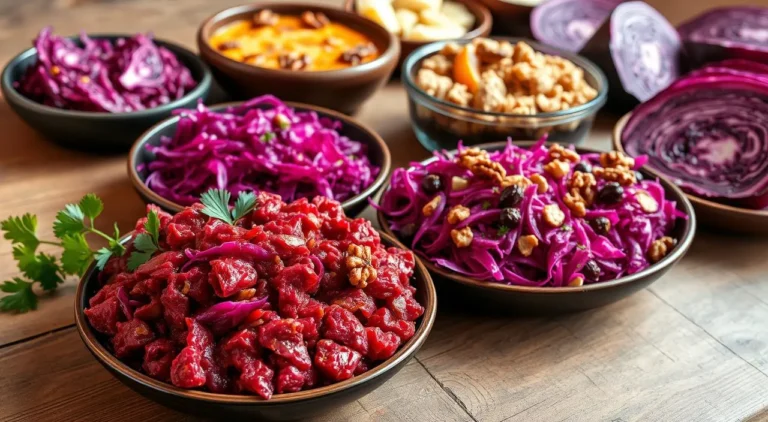Master the Art of Homemade Kimchi: A Step-by-Step Guide to Fermented Perfection
Kimchi, the iconic Korean fermented dish, is more than just a side dish—it’s a cultural cornerstone and a powerhouse of flavor and nutrition. Have you ever wondered why over 95% of South Koreans consume kimchi daily ? Its global popularity has surged by 30% in the last five years , making it a must-try for food enthusiasts. If you’re curious about how to make kimchi at home , this guide will walk you through the process step-by-step, ensuring you achieve tangy, spicy perfection. Let’s dive into this exciting journey to ferment deliciousness.
Ingredients List
Before getting started with how to make kimchi at home , let’s gather everything you’ll need. The magic of kimchi lies in its vibrant blend of ingredients, each contributing to its unique taste and texture. To begin with, here’s what you’ll need:
Core Ingredients:
- 1 large head of Napa cabbage (about 2 lbs): Look for fresh, crisp leaves to ensure the best results.
- 1 cup Korean chili powder (gochugaru): Adjust the amount based on your spice tolerance.
- 1/4 cup fish sauce or salted shrimp: This adds umami depth; alternatively, opt for vegan substitutes like soy sauce if needed.
- 1 tablespoon grated ginger: Freshly grated ginger provides maximum zing.
- 4 cloves garlic, minced: Garlic is essential for delivering that signature kick.
- 1 medium daikon radish, julienned: Adding crunch and sweetness, the radish complements the dish beautifully.
- 4 green onions, sliced: These bring freshness and a pop of color.
- 1/4 cup sugar: Balances the heat and saltiness for a well-rounded flavor.
- Water and salt for brining: Use non-iodized salt for optimal fermentation.
Substitutions & Tips:
If gochugaru isn’t available, cayenne pepper can be used as a substitute, though it may lack the smoky depth of traditional kimchi. For those avoiding fish sauce, miso paste or tamari works as a savory alternative. Additionally, gluten-free eaters should ensure their sauces are certified gluten-free.
Each ingredient plays a crucial role in crafting kimchi’s complex flavors, so prioritize quality. After all, freshness makes all the difference when learning how to make kimchi at home !
Timing
Making kimchi at home is surprisingly manageable, even for beginners. First, let’s break down the time commitment involved in how to make kimchi at home :
- Preparation Time: Around 30 minutes for cleaning, chopping, and mixing.
- Brining Time: Allow 2–6 hours—or even overnight—for deeper flavor infusion.
- Fermentation Time: Leave it at room temperature for 1–5 days, depending on your desired level of tanginess.
Compared to other fermented foods like sauerkraut, which can take weeks, kimchi ferments relatively quickly. Consequently, it’s an accessible project for busy cooks who want to experiment with fermentation while mastering how to make kimchi at home .
Step-by-Step Instructions
Step 1: Prepare the Cabbage
To start, cut the Napa cabbage into bite-sized pieces and rinse thoroughly under cold water. Next, dissolve 1/2 cup of salt in 8 cups of water to create a brine. Submerge the cabbage in the brine, ensuring all pieces are fully covered. Let it sit for 2–6 hours.
Pro Tip: Place a plate on top of the cabbage to keep it submerged during brining.
Step 2: Make the Kimchi Paste
In a large bowl, combine gochugaru, fish sauce, ginger, garlic, sugar, and 1/2 cup of water. Mix until smooth. Then, add the julienned radish and sliced green onions to the paste, coating them evenly.
Step 3: Combine and Pack
Once the brining is complete, drain the cabbage and rinse it twice to remove excess salt. Pat dry with paper towels. Afterward, toss the cabbage with the kimchi paste, ensuring every leaf is coated. Finally, pack the mixture tightly into a sterilized glass jar, pressing down to eliminate air pockets.
Step 4: Ferment
Seal the jar loosely to allow gases to escape during fermentation. Store it at room temperature for 1–5 days, checking daily for bubbles—a sign of active fermentation. Once it reaches your preferred tanginess, refrigerate to slow down the process.
Nutritional Information
Kimchi isn’t just delicious—it’s packed with health benefits! Here’s a breakdown per 1-cup serving:
According to a study published in Frontiers in Microbiology , kimchi contains over 100 strains of beneficial bacteria , making it one of the most probiotic-rich foods available. Therefore, incorporating it into your diet supports gut health and boosts immunity—another reason to learn how to make kimchi at home .
Healthier Alternatives for the Recipe
For those seeking healthier alternatives, consider these tweaks:
- Lower the sodium content by reducing the amount of salt in the brine and opting for low-sodium fish sauce.
- Create a vegan-friendly version by swapping fish sauce with seaweed broth or miso paste.
- Make it low-carb by skipping the sugar entirely or replacing it with a keto-friendly sweetener like erythritol.
Clearly, there are many ways to adapt this recipe to suit various dietary needs while mastering how to make kimchi at home .
Serving Suggestions
Kimchi is incredibly versatile. For instance, here are some creative ways to enjoy it:
- Serve as a side dish alongside grilled meats or tofu.
- Stir it into fried rice for a quick weeknight meal.
- Top tacos, burgers, or grain bowls for an instant flavor boost.
Personalized Tip: Pair kimchi with steamed rice and a fried egg for a comforting breakfast-for-dinner option.
Common Mistakes to Avoid
When making kimchi, it’s important to avoid common pitfalls:
- Over-salting can inhibit fermentation. Always taste-test your brine before adding it to the cabbage.
- Skipping sterilization increases the risk of spoilage. Always use clean jars.
- Rushing fermentation compromises flavor development. Patience ensures the best results.
By keeping these tips in mind, you’ll set yourself up for success as you learn how to make kimchi at home .
Storing Tips for the Recipe
After fermentation, store kimchi in the refrigerator to extend its shelf life (up to 3 months). Use airtight containers to preserve flavor and prevent odors from spreading. Furthermore, always use clean utensils when scooping kimchi to avoid contamination.
Conclusion
In summary, kimchi is a celebration of bold flavors, healthy living, and culinary tradition. With this step-by-step guide, you now know how to make kimchi at home and can confidently embark on your fermentation journey. Ready to give it a try? Share your experience in the comments below or leave a review—we’d love to hear how your kimchi turned out! Don’t forget to subscribe for more updates and recipes.
FAQs
Q1: Can I make kimchi without chili powder?
Yes, omit the gochugaru for a milder version, although the flavor profile will differ slightly.
Q2: How do I know if my kimchi has gone bad?
Signs include off smells, mold growth, or an excessively sour taste. Proper storage prevents spoilage.
Q3: Is store-bought kimchi as good as homemade?
While convenient, store-bought versions often contain preservatives. Homemade kimchi offers fresher flavors and customizable ingredients.
Q4: Can I freeze kimchi?
Yes, freezing halts fermentation but may alter texture. Thaw before using.
Q5: What makes kimchi probiotic-rich?
Lactic acid bacteria thrive during fermentation, creating billions of colony-forming units (CFUs) that support gut health.







